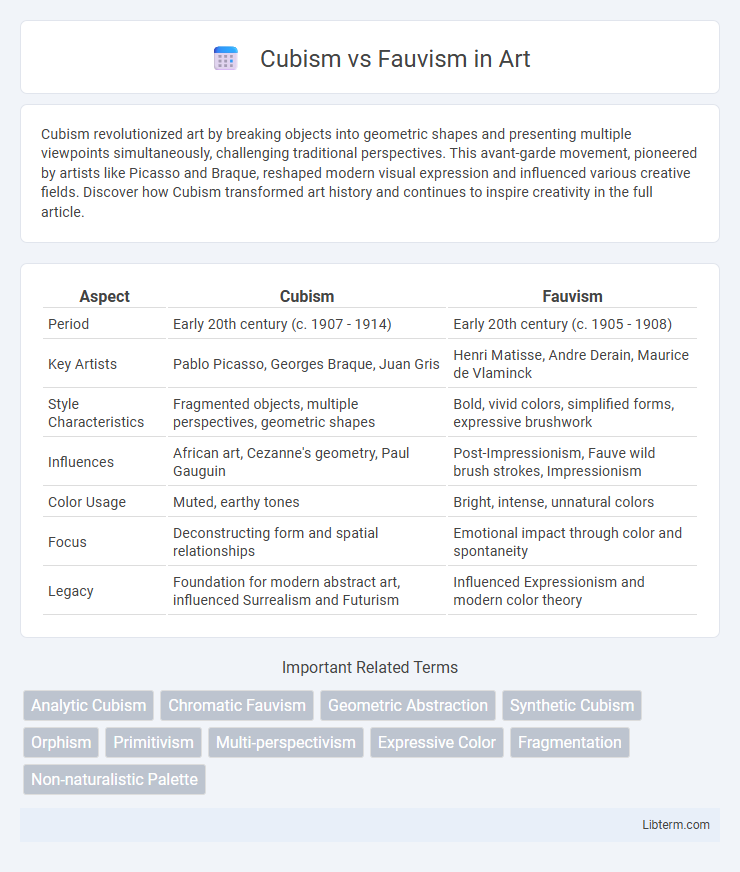Cubism revolutionized art by breaking objects into geometric shapes and presenting multiple viewpoints simultaneously, challenging traditional perspectives. This avant-garde movement, pioneered by artists like Picasso and Braque, reshaped modern visual expression and influenced various creative fields. Discover how Cubism transformed art history and continues to inspire creativity in the full article.
Table of Comparison
| Aspect | Cubism | Fauvism |
|---|---|---|
| Period | Early 20th century (c. 1907 - 1914) | Early 20th century (c. 1905 - 1908) |
| Key Artists | Pablo Picasso, Georges Braque, Juan Gris | Henri Matisse, Andre Derain, Maurice de Vlaminck |
| Style Characteristics | Fragmented objects, multiple perspectives, geometric shapes | Bold, vivid colors, simplified forms, expressive brushwork |
| Influences | African art, Cezanne's geometry, Paul Gauguin | Post-Impressionism, Fauve wild brush strokes, Impressionism |
| Color Usage | Muted, earthy tones | Bright, intense, unnatural colors |
| Focus | Deconstructing form and spatial relationships | Emotional impact through color and spontaneity |
| Legacy | Foundation for modern abstract art, influenced Surrealism and Futurism | Influenced Expressionism and modern color theory |
Introduction to Cubism and Fauvism
Cubism, pioneered by Pablo Picasso and Georges Braque in the early 20th century, radically transformed visual art by breaking subjects into geometric shapes and presenting multiple viewpoints simultaneously. Fauvism, led by Henri Matisse and Andre Derain, emphasized vivid, non-naturalistic colors and simplified forms to evoke emotional resonance rather than realistic representation. Both movements redefined artistic expression by challenging traditional techniques and influencing the trajectory of modern art.
Origins and Historical Context
Cubism originated in the early 20th century, primarily developed by Pablo Picasso and Georges Braque in Paris between 1907 and 1914, marking a radical shift in depicting perspective and form by breaking objects into geometric shapes. Fauvism emerged slightly earlier, around 1904 to 1908, led by Henri Matisse and Andre Derain, centered in France, characterized by bold, vibrant colors and emotional expression, rejecting traditional representation. Both movements arose during a period of rapid artistic experimentation and societal change, reflecting the quest to redefine visual art amidst modernity.
Key Artists and Influencers
Cubism, pioneered by Pablo Picasso and Georges Braque, revolutionized modern art through fragmented forms and multiple perspectives, influencing artists like Juan Gris and Fernand Leger. Fauvism, led by Henri Matisse and Andre Derain, emphasized bold colors and expressive brushwork, inspiring figures such as Maurice de Vlaminck and Kees van Dongen. Both movements profoundly shaped 20th-century art, with Cubism focusing on structural analysis and Fauvism prioritizing vibrant emotional expression.
Core Philosophies and Inspirations
Cubism revolutionized art by breaking objects into geometric shapes, emphasizing multiple perspectives simultaneously and challenging traditional representation. Fauvism prioritized vibrant color and emotional expression, inspired by primitive art and the natural world to evoke raw, instinctive reactions. Both movements rejected realism but diverged in their philosophical focus--Cubism on intellectual analysis of form, Fauvism on bold, sensory impact.
Distinctive Styles and Techniques
Cubism, pioneered by Pablo Picasso and Georges Braque, breaks down objects into geometric shapes and multiple viewpoints, emphasizing fragmented forms and muted color palettes to depict subjects from various angles simultaneously. Fauvism, led by Henri Matisse, uses bold, vibrant colors and simplified forms with strong, expressive brushstrokes to evoke emotional intensity rather than realistic representation. While Cubism focuses on structural complexity and spatial deconstruction, Fauvism prioritizes vivid color and painterly freedom.
Use of Color and Form
Cubism deconstructs objects into geometric shapes and multiple perspectives, emphasizing fragmented forms over realistic representation, while Fauvism uses vivid, non-naturalistic colors to evoke emotional intensity. Cubist artists like Picasso and Braque prioritize muted tones and complex spatial relationships, contrasting with Fauvist painters such as Matisse who employ bold, saturated colors and simplified forms. The distinction lies in Cubism's analytical approach to form and subdued palette versus Fauvism's expressive color and flattened shapes.
Major Works and Masterpieces
Cubism's major works include Pablo Picasso's "Les Demoiselles d'Avignon" (1907) and Georges Braque's "Violin and Candlestick" (1910), showcasing fragmented forms and multiple perspectives. Fauvism is exemplified by Henri Matisse's "Woman with a Hat" (1905) and Andre Derain's "Charing Cross Bridge" (1906), characterized by bold colors and simplified shapes. Both movements revolutionized modern art with Cubism emphasizing structural deconstruction while Fauvism prioritized expressive color.
Reception and Impact on the Art World
Cubism, pioneered by Pablo Picasso and Georges Braque, revolutionized the art world by challenging traditional perspectives and inspiring the development of modern abstract art, receiving both critical acclaim and controversy for its fragmented forms. Fauvism, led by Henri Matisse, gained attention for its bold use of color and emotional intensity, influencing Expressionism and shaping the trajectory of early 20th-century modernism despite initial shock from conservative critics. Both movements played pivotal roles in breaking away from realism, significantly impacting subsequent artistic styles and the acceptance of innovative artistic expressions globally.
Legacy and Contemporary Influence
Cubism revolutionized visual art by introducing fragmented perspectives and abstract forms, profoundly influencing modern sculpture, architecture, and graphic design. Fauvism's bold use of color and expressive brushwork reshaped modern painting, inspiring movements like Expressionism and Abstract Expressionism. Both movements continue to impact contemporary art practices, with artists integrating Cubist structural analysis and Fauvist vibrant palettes to challenge traditional aesthetics.
Cubism vs Fauvism: Key Differences Summarized
Cubism and Fauvism are distinguished primarily by their approach to form and color; Cubism, pioneered by Pablo Picasso and Georges Braque, emphasizes fragmented, geometric shapes and multiple perspectives to depict subjects, while Fauvism, led by Henri Matisse, prioritizes bold, vibrant colors and simplified forms to evoke emotional expression. Cubism's analytical technique breaks down objects into abstracted planes, contrasting with Fauvism's spontaneous, painterly brushstrokes and vivid palette that reject traditional realism. The movement timelines also differ, with Fauvism peaking around 1905-1908 and Cubism dominating from 1907 through the 1920s.
Cubism Infographic

 libterm.com
libterm.com